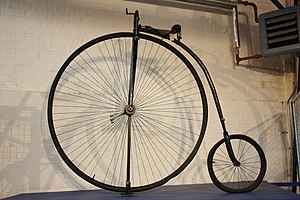
Back Drátové kolo Czech Rueda de radios Spanish Roue à rayons French Ruji JV Koleso s drôteným výpletom Slovak


Wire wheels, wire-spoked wheels, tension-spoked wheels, or "suspension" wheels are wheels whose rims connect to their hubs by wire spokes.[1][2][3] Although these wires are considerably stiffer than a similar diameter wire rope, they function mechanically the same as tensioned flexible wires, keeping the rim true while supporting applied loads. The term suspension wheel should not be confused with vehicle suspension.[3]
Wire wheels are used on most bicycles and are still used on many motorcycles. They were invented by aeronautical engineer George Cayley in 1808.[4] Although Cayley first proposed wire wheels, he did not apply for a patent. The first patent for wire wheels was issued to Theodore Jones of London, England on October 11, 1826.[5] Eugène Meyer of Paris, France was the first person to receive, in 1869, a patent for wire wheels on bicycles.[6]
Bicycle wheels were not strong enough for cars until the development of tangentially spoked wheels. They rapidly became well established in the bicycle and motor tricycle world but were not common on cars until around 1907. This was encouraged by the Rudge-Whitworth patented detachable and interchangeable wheels designed by John Pugh. These wheels owed their resistance to braking and accelerative stresses to their two inner rows of tangential spokes. An outer row of radial spokes gave lateral strength against cornering stresses. These wheels were deeply dished so that steering pivot pins might lie as near as possible to the center-line of the tires. Their second feature was that they were easily detachable being mounted on splined false hubs. A process of assembling wire wheels is described as wheelbuilding.
- ^ Cite error: The named reference
forrester1980was invoked but never defined (see the help page). - ^ Cite error: The named reference
Brownwas invoked but never defined (see the help page). - ^ a b Cite error: The named reference
Walker1920was invoked but never defined (see the help page). - ^ Ackroyd, J.A.D. (2011). "Sir George Cayley: The invention of the aeroplane near Scarborough at the time of Trafalgar" (PDF). Journal of Aeronautical History (6): 152.
In the same month, March 1808, the notebook records his invention of the tension wheel in his search for "the lightest possible wheel for aerial navigation cars". His idea is ".. to do away wooden spokes altogether, and refer the whole firmness of the wheel to the strength of the rim only, by the intervention of tight strong cording.."
- ^ See:
- Notice of Theodore Jones' patent for wire wheels: Repertory of patent inventions, etc., no. 17 (November 1826), page 320.
- Illustrations and description of Jones' wire wheel: Luke Hebert, ed. (April 20, 1828) "Patent suspension wheels," The Register of Arts, and Journal of Patent Inventions, 2nd series, 2 (29) : pages 65-66.
- ^ Bulletin des lois de la République française (1873) 12th series, vol. 6, page 648, patent no. 86,705: "Perfectionnements dans les roues de vélocipèdes" (Improvements in the wheels of bicycles), issued: 4 August 1869.
© MMXXIII Rich X Search. We shall prevail. All rights reserved. Rich X Search